NZDB 502 - Strategic Analysis and Planning for Auckland Airport
VerifiedAdded on 2023/01/30
|60
|19035
|92
Report
AI Summary
This report presents a strategic analysis of Auckland Airport, focusing on its internal resources, external environment, and stakeholder management. The analysis employs tools such as value chain analysis, VRIO framework, PESTLE analysis, and Porter's Five Forces to evaluate the airport's strengths, weaknesses, opportunities, and threats. The report identifies key strategic objectives, including expanding fleet capacity, increasing profitability, and accommodating a larger number of passengers. Recommendations are provided to achieve these objectives, such as focusing on long-term vision, developing new projects, and establishing effective communication with stakeholders. The report concludes by emphasizing the importance of strategic planning in achieving the airport's vision, values, and sustainable competitive advantage. Furthermore, the report incorporates the Treaty of Waitangi principles, acknowledging the bi-cultural partnership of the company and its impact on strategic relationships and activities.
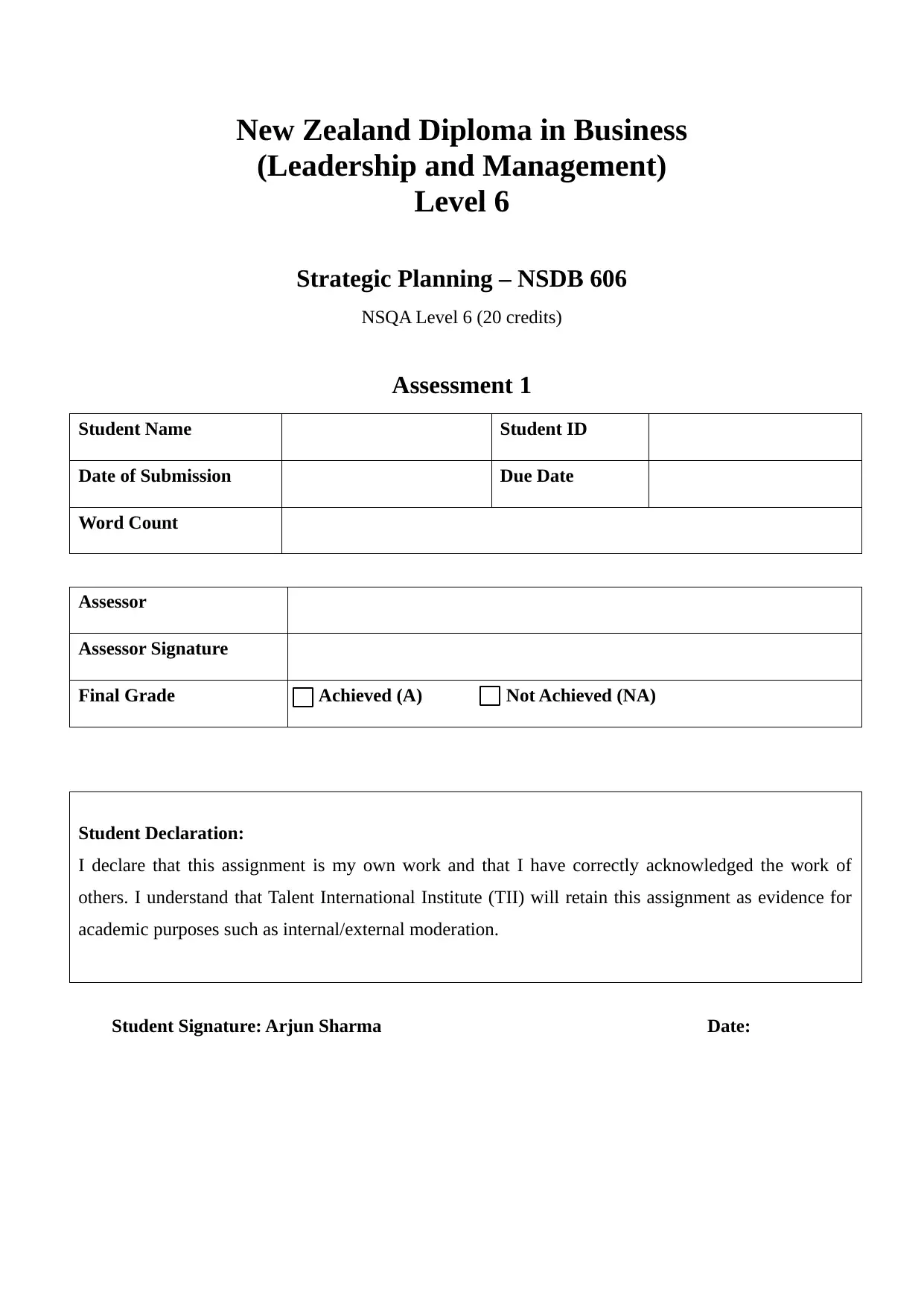
New Zealand Diploma in Business
(Leadership and Management)
Level 6
Strategic Planning – NSDB 606
NSQA Level 6 (20 credits)
Assessment 1
Student Name Student ID
Date of Submission Due Date
Word Count
Assessor
Assessor Signature
Final Grade Achieved (A) Not Achieved (NA)
Student Declaration:
I declare that this assignment is my own work and that I have correctly acknowledged the work of
others. I understand that Talent International Institute (TII) will retain this assignment as evidence for
academic purposes such as internal/external moderation.
Student Signature: Arjun Sharma Date:
(Leadership and Management)
Level 6
Strategic Planning – NSDB 606
NSQA Level 6 (20 credits)
Assessment 1
Student Name Student ID
Date of Submission Due Date
Word Count
Assessor
Assessor Signature
Final Grade Achieved (A) Not Achieved (NA)
Student Declaration:
I declare that this assignment is my own work and that I have correctly acknowledged the work of
others. I understand that Talent International Institute (TII) will retain this assignment as evidence for
academic purposes such as internal/external moderation.
Student Signature: Arjun Sharma Date:
Paraphrase This Document
Need a fresh take? Get an instant paraphrase of this document with our AI Paraphraser
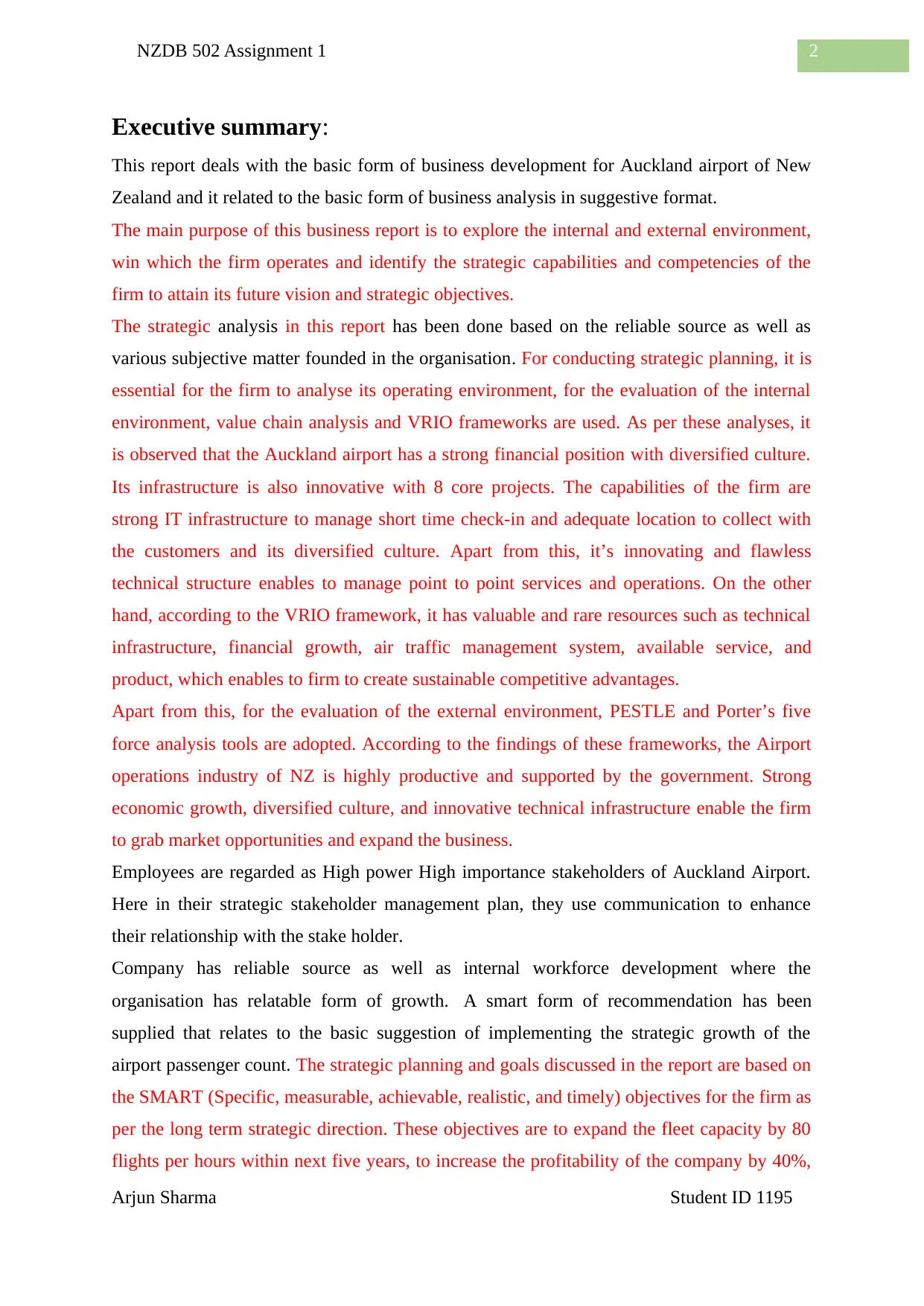
2NZDB 502 Assignment 1
Executive summary:
This report deals with the basic form of business development for Auckland airport of New
Zealand and it related to the basic form of business analysis in suggestive format.
The main purpose of this business report is to explore the internal and external environment,
win which the firm operates and identify the strategic capabilities and competencies of the
firm to attain its future vision and strategic objectives.
The strategic analysis in this report has been done based on the reliable source as well as
various subjective matter founded in the organisation. For conducting strategic planning, it is
essential for the firm to analyse its operating environment, for the evaluation of the internal
environment, value chain analysis and VRIO frameworks are used. As per these analyses, it
is observed that the Auckland airport has a strong financial position with diversified culture.
Its infrastructure is also innovative with 8 core projects. The capabilities of the firm are
strong IT infrastructure to manage short time check-in and adequate location to collect with
the customers and its diversified culture. Apart from this, it’s innovating and flawless
technical structure enables to manage point to point services and operations. On the other
hand, according to the VRIO framework, it has valuable and rare resources such as technical
infrastructure, financial growth, air traffic management system, available service, and
product, which enables to firm to create sustainable competitive advantages.
Apart from this, for the evaluation of the external environment, PESTLE and Porter’s five
force analysis tools are adopted. According to the findings of these frameworks, the Airport
operations industry of NZ is highly productive and supported by the government. Strong
economic growth, diversified culture, and innovative technical infrastructure enable the firm
to grab market opportunities and expand the business.
Employees are regarded as High power High importance stakeholders of Auckland Airport.
Here in their strategic stakeholder management plan, they use communication to enhance
their relationship with the stake holder.
Company has reliable source as well as internal workforce development where the
organisation has relatable form of growth. A smart form of recommendation has been
supplied that relates to the basic suggestion of implementing the strategic growth of the
airport passenger count. The strategic planning and goals discussed in the report are based on
the SMART (Specific, measurable, achievable, realistic, and timely) objectives for the firm as
per the long term strategic direction. These objectives are to expand the fleet capacity by 80
flights per hours within next five years, to increase the profitability of the company by 40%,
Arjun Sharma Student ID 1195
Executive summary:
This report deals with the basic form of business development for Auckland airport of New
Zealand and it related to the basic form of business analysis in suggestive format.
The main purpose of this business report is to explore the internal and external environment,
win which the firm operates and identify the strategic capabilities and competencies of the
firm to attain its future vision and strategic objectives.
The strategic analysis in this report has been done based on the reliable source as well as
various subjective matter founded in the organisation. For conducting strategic planning, it is
essential for the firm to analyse its operating environment, for the evaluation of the internal
environment, value chain analysis and VRIO frameworks are used. As per these analyses, it
is observed that the Auckland airport has a strong financial position with diversified culture.
Its infrastructure is also innovative with 8 core projects. The capabilities of the firm are
strong IT infrastructure to manage short time check-in and adequate location to collect with
the customers and its diversified culture. Apart from this, it’s innovating and flawless
technical structure enables to manage point to point services and operations. On the other
hand, according to the VRIO framework, it has valuable and rare resources such as technical
infrastructure, financial growth, air traffic management system, available service, and
product, which enables to firm to create sustainable competitive advantages.
Apart from this, for the evaluation of the external environment, PESTLE and Porter’s five
force analysis tools are adopted. According to the findings of these frameworks, the Airport
operations industry of NZ is highly productive and supported by the government. Strong
economic growth, diversified culture, and innovative technical infrastructure enable the firm
to grab market opportunities and expand the business.
Employees are regarded as High power High importance stakeholders of Auckland Airport.
Here in their strategic stakeholder management plan, they use communication to enhance
their relationship with the stake holder.
Company has reliable source as well as internal workforce development where the
organisation has relatable form of growth. A smart form of recommendation has been
supplied that relates to the basic suggestion of implementing the strategic growth of the
airport passenger count. The strategic planning and goals discussed in the report are based on
the SMART (Specific, measurable, achievable, realistic, and timely) objectives for the firm as
per the long term strategic direction. These objectives are to expand the fleet capacity by 80
flights per hours within next five years, to increase the profitability of the company by 40%,
Arjun Sharma Student ID 1195
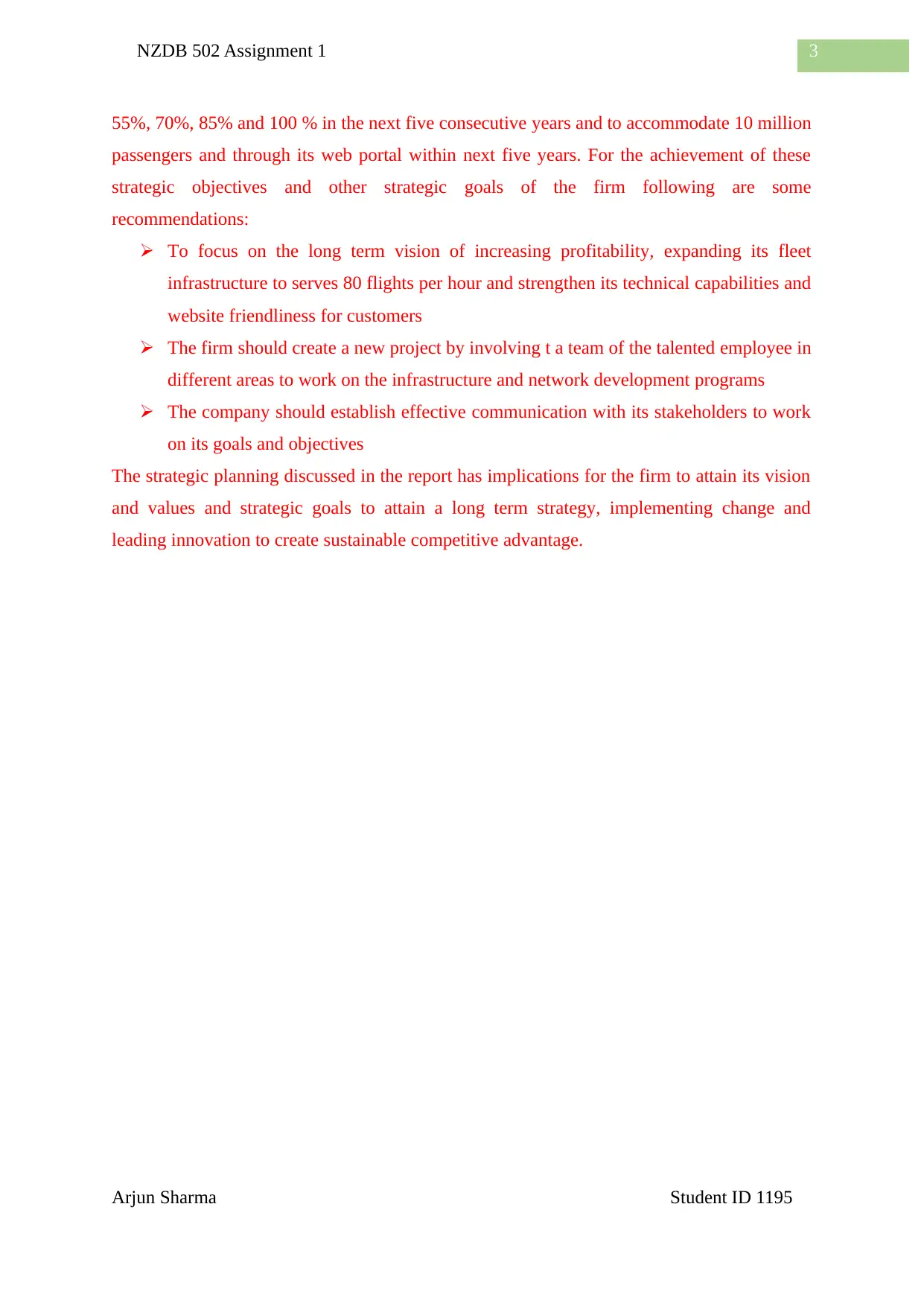
3NZDB 502 Assignment 1
55%, 70%, 85% and 100 % in the next five consecutive years and to accommodate 10 million
passengers and through its web portal within next five years. For the achievement of these
strategic objectives and other strategic goals of the firm following are some
recommendations:
To focus on the long term vision of increasing profitability, expanding its fleet
infrastructure to serves 80 flights per hour and strengthen its technical capabilities and
website friendliness for customers
The firm should create a new project by involving t a team of the talented employee in
different areas to work on the infrastructure and network development programs
The company should establish effective communication with its stakeholders to work
on its goals and objectives
The strategic planning discussed in the report has implications for the firm to attain its vision
and values and strategic goals to attain a long term strategy, implementing change and
leading innovation to create sustainable competitive advantage.
Arjun Sharma Student ID 1195
55%, 70%, 85% and 100 % in the next five consecutive years and to accommodate 10 million
passengers and through its web portal within next five years. For the achievement of these
strategic objectives and other strategic goals of the firm following are some
recommendations:
To focus on the long term vision of increasing profitability, expanding its fleet
infrastructure to serves 80 flights per hour and strengthen its technical capabilities and
website friendliness for customers
The firm should create a new project by involving t a team of the talented employee in
different areas to work on the infrastructure and network development programs
The company should establish effective communication with its stakeholders to work
on its goals and objectives
The strategic planning discussed in the report has implications for the firm to attain its vision
and values and strategic goals to attain a long term strategy, implementing change and
leading innovation to create sustainable competitive advantage.
Arjun Sharma Student ID 1195
⊘ This is a preview!⊘
Do you want full access?
Subscribe today to unlock all pages.

Trusted by 1+ million students worldwide
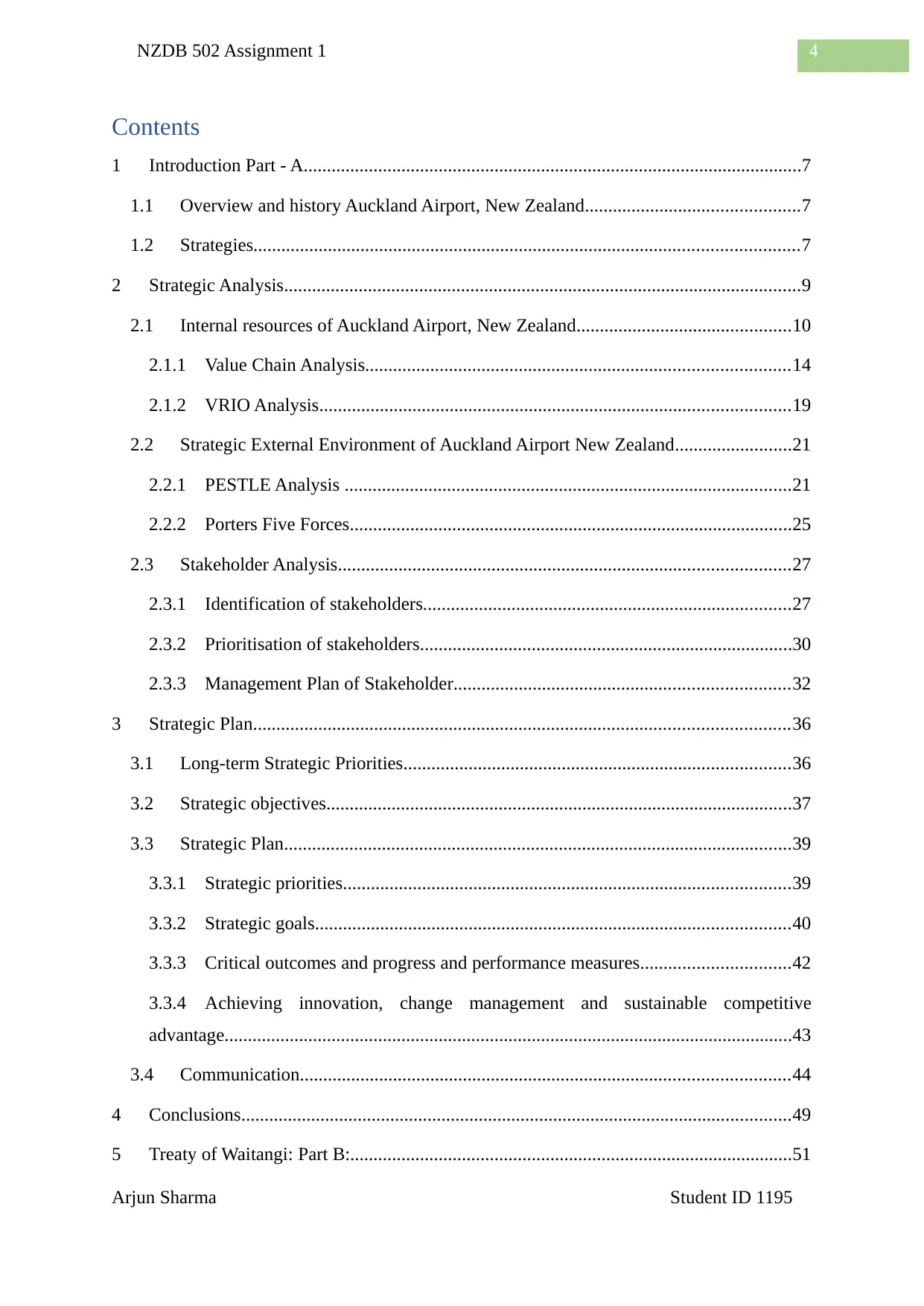
4NZDB 502 Assignment 1
Contents
1 Introduction Part - A...........................................................................................................7
1.1 Overview and history Auckland Airport, New Zealand..............................................7
1.2 Strategies.....................................................................................................................7
2 Strategic Analysis...............................................................................................................9
2.1 Internal resources of Auckland Airport, New Zealand..............................................10
2.1.1 Value Chain Analysis...........................................................................................14
2.1.2 VRIO Analysis.....................................................................................................19
2.2 Strategic External Environment of Auckland Airport New Zealand.........................21
2.2.1 PESTLE Analysis ................................................................................................21
2.2.2 Porters Five Forces...............................................................................................25
2.3 Stakeholder Analysis.................................................................................................27
2.3.1 Identification of stakeholders...............................................................................27
2.3.2 Prioritisation of stakeholders................................................................................30
2.3.3 Management Plan of Stakeholder........................................................................32
3 Strategic Plan...................................................................................................................36
3.1 Long-term Strategic Priorities...................................................................................36
3.2 Strategic objectives....................................................................................................37
3.3 Strategic Plan.............................................................................................................39
3.3.1 Strategic priorities................................................................................................39
3.3.2 Strategic goals......................................................................................................40
3.3.3 Critical outcomes and progress and performance measures................................42
3.3.4 Achieving innovation, change management and sustainable competitive
advantage..........................................................................................................................43
3.4 Communication.........................................................................................................44
4 Conclusions......................................................................................................................49
5 Treaty of Waitangi: Part B:...............................................................................................51
Arjun Sharma Student ID 1195
Contents
1 Introduction Part - A...........................................................................................................7
1.1 Overview and history Auckland Airport, New Zealand..............................................7
1.2 Strategies.....................................................................................................................7
2 Strategic Analysis...............................................................................................................9
2.1 Internal resources of Auckland Airport, New Zealand..............................................10
2.1.1 Value Chain Analysis...........................................................................................14
2.1.2 VRIO Analysis.....................................................................................................19
2.2 Strategic External Environment of Auckland Airport New Zealand.........................21
2.2.1 PESTLE Analysis ................................................................................................21
2.2.2 Porters Five Forces...............................................................................................25
2.3 Stakeholder Analysis.................................................................................................27
2.3.1 Identification of stakeholders...............................................................................27
2.3.2 Prioritisation of stakeholders................................................................................30
2.3.3 Management Plan of Stakeholder........................................................................32
3 Strategic Plan...................................................................................................................36
3.1 Long-term Strategic Priorities...................................................................................36
3.2 Strategic objectives....................................................................................................37
3.3 Strategic Plan.............................................................................................................39
3.3.1 Strategic priorities................................................................................................39
3.3.2 Strategic goals......................................................................................................40
3.3.3 Critical outcomes and progress and performance measures................................42
3.3.4 Achieving innovation, change management and sustainable competitive
advantage..........................................................................................................................43
3.4 Communication.........................................................................................................44
4 Conclusions......................................................................................................................49
5 Treaty of Waitangi: Part B:...............................................................................................51
Arjun Sharma Student ID 1195
Paraphrase This Document
Need a fresh take? Get an instant paraphrase of this document with our AI Paraphraser

5NZDB 502 Assignment 1
5.1 Company overview....................................................................................................51
5.2 Origins of Bi-Cultural partnership.............................................................................51
5.2.1 Three principles of the Treaty of Waitangi...........................................................52
5.2.2 Analysis of impact of Bi-cultural partnership on strategic relationships and
activities of the company.................................................................................................54
6 References........................................................................................................................57
Table of Figures
Figure 1: Value Chain Analysis................................................................................................15
Figure 2: VRIO framework......................................................................................................19
Figure 3: Porter Five Force Framework...................................................................................25
Figure 4: Stakeholder Power- Interest Matrix.........................................................................30
Figure 5: Power-Interest Matrix of Auckland Airport..............................................................32
Figure 6: Three principles of the Treaty of Waitangi...............................................................54
Table of Tables
Table 1 Analysis of Internal Resources, Capabilities and Competencies of Auckland Airport
New Zealand............................................................................................................................10
Table 2 Identification of Internal Competencies of Auckland Airport New Zealand..............18
Table 3 Assessment of Resources, Capabilities and Competencies of Auckland Airport New
Zealand.....................................................................................................................................20
Table 4 Evaluation of External Environment of Auckland Airport New Zealand...................22
Table 5: Stakeholder Identification..........................................................................................27
Table 6 Stakeholder Management Plan....................................................................................32
Table 7 Vision, Values and Strategic Direction........................................................................36
Table 8 Strategic Objectives.....................................................................................................37
Table 9 Strategic Focus Areas..................................................................................................39
Table 10 Strategic Goals..........................................................................................................40
Arjun Sharma Student ID 1195
5.1 Company overview....................................................................................................51
5.2 Origins of Bi-Cultural partnership.............................................................................51
5.2.1 Three principles of the Treaty of Waitangi...........................................................52
5.2.2 Analysis of impact of Bi-cultural partnership on strategic relationships and
activities of the company.................................................................................................54
6 References........................................................................................................................57
Table of Figures
Figure 1: Value Chain Analysis................................................................................................15
Figure 2: VRIO framework......................................................................................................19
Figure 3: Porter Five Force Framework...................................................................................25
Figure 4: Stakeholder Power- Interest Matrix.........................................................................30
Figure 5: Power-Interest Matrix of Auckland Airport..............................................................32
Figure 6: Three principles of the Treaty of Waitangi...............................................................54
Table of Tables
Table 1 Analysis of Internal Resources, Capabilities and Competencies of Auckland Airport
New Zealand............................................................................................................................10
Table 2 Identification of Internal Competencies of Auckland Airport New Zealand..............18
Table 3 Assessment of Resources, Capabilities and Competencies of Auckland Airport New
Zealand.....................................................................................................................................20
Table 4 Evaluation of External Environment of Auckland Airport New Zealand...................22
Table 5: Stakeholder Identification..........................................................................................27
Table 6 Stakeholder Management Plan....................................................................................32
Table 7 Vision, Values and Strategic Direction........................................................................36
Table 8 Strategic Objectives.....................................................................................................37
Table 9 Strategic Focus Areas..................................................................................................39
Table 10 Strategic Goals..........................................................................................................40
Arjun Sharma Student ID 1195
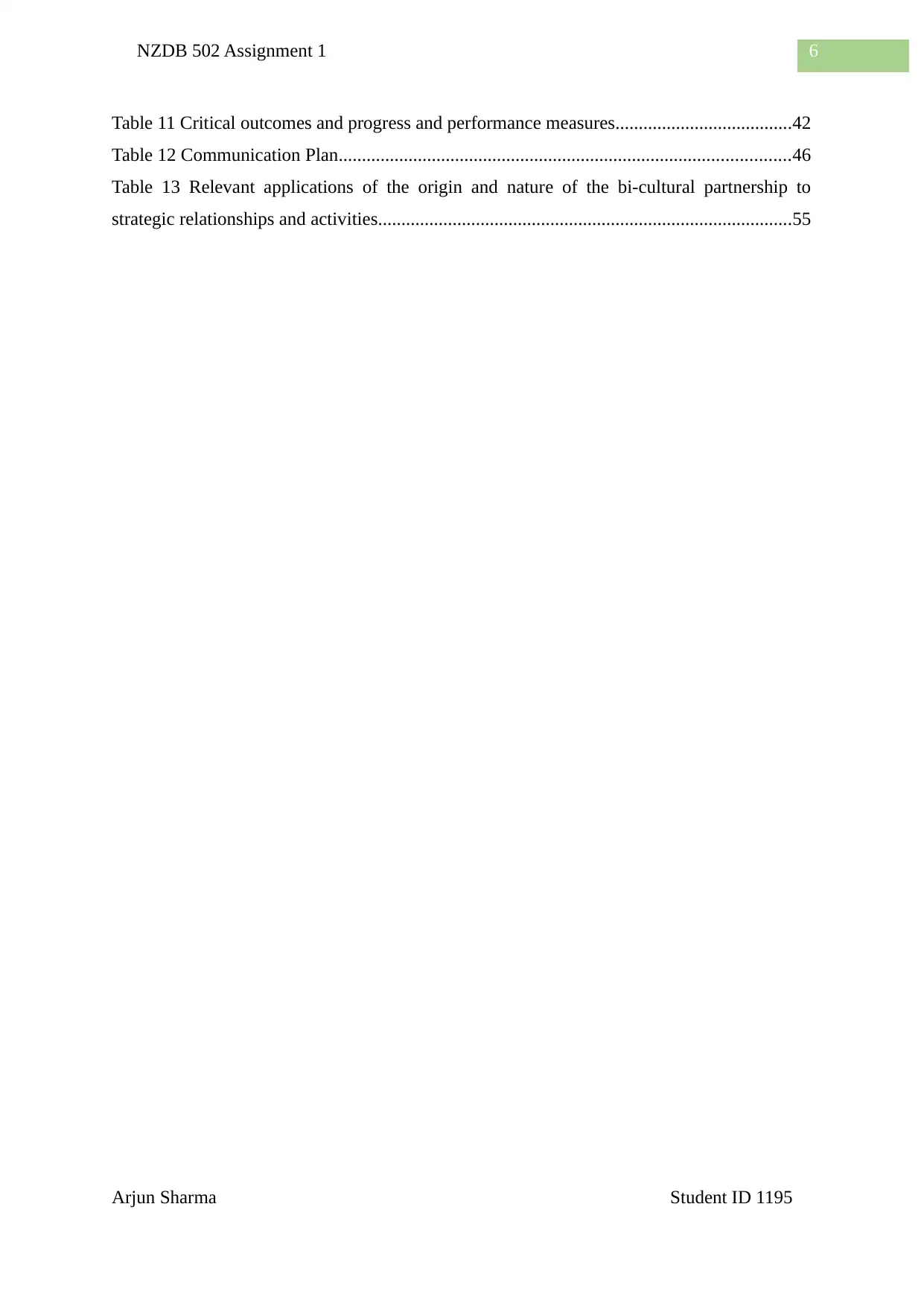
6NZDB 502 Assignment 1
Table 11 Critical outcomes and progress and performance measures......................................42
Table 12 Communication Plan.................................................................................................46
Table 13 Relevant applications of the origin and nature of the bi-cultural partnership to
strategic relationships and activities.........................................................................................55
Arjun Sharma Student ID 1195
Table 11 Critical outcomes and progress and performance measures......................................42
Table 12 Communication Plan.................................................................................................46
Table 13 Relevant applications of the origin and nature of the bi-cultural partnership to
strategic relationships and activities.........................................................................................55
Arjun Sharma Student ID 1195
⊘ This is a preview!⊘
Do you want full access?
Subscribe today to unlock all pages.

Trusted by 1+ million students worldwide
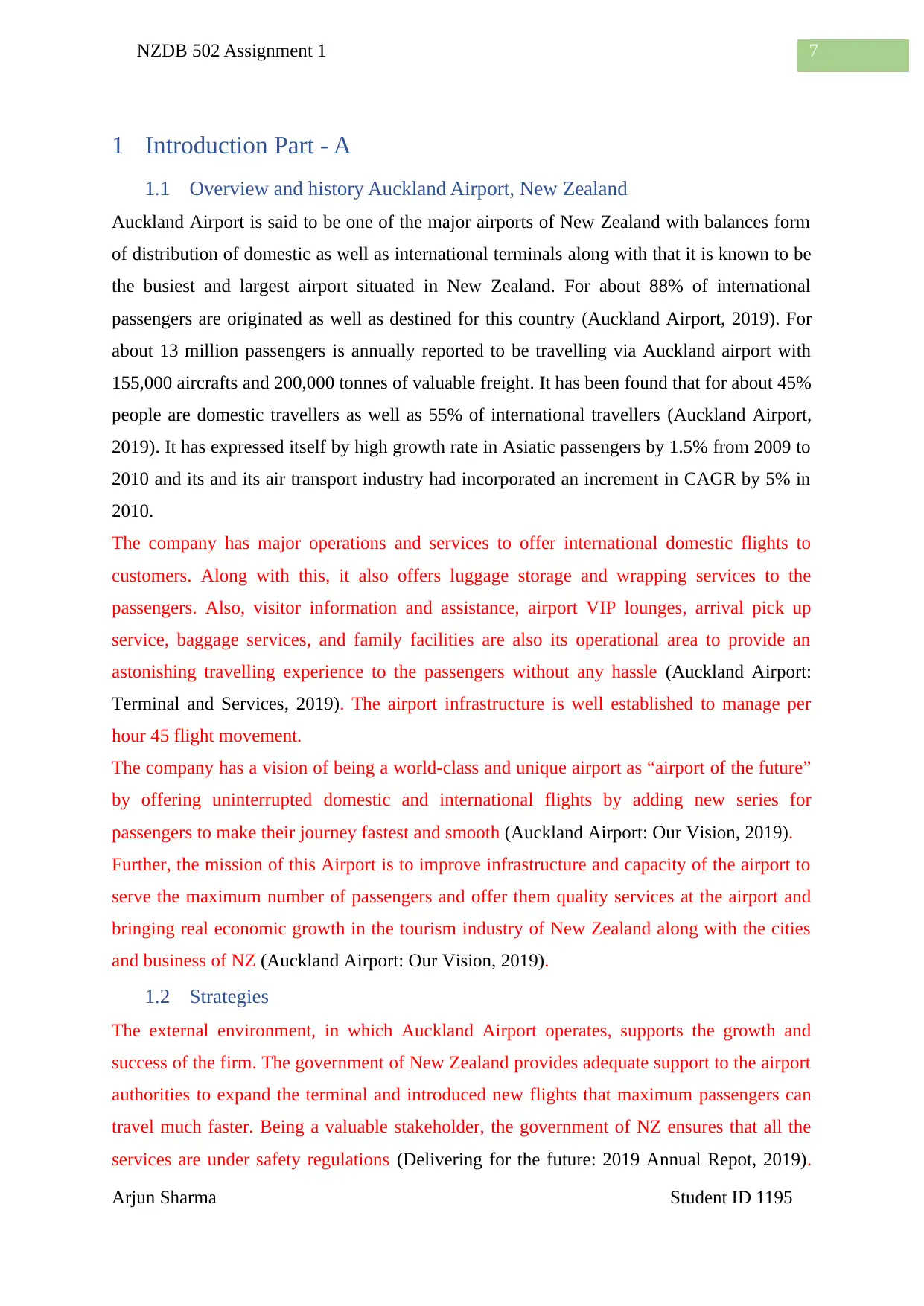
7NZDB 502 Assignment 1
1 Introduction Part - A
1.1 Overview and history Auckland Airport, New Zealand
Auckland Airport is said to be one of the major airports of New Zealand with balances form
of distribution of domestic as well as international terminals along with that it is known to be
the busiest and largest airport situated in New Zealand. For about 88% of international
passengers are originated as well as destined for this country (Auckland Airport, 2019). For
about 13 million passengers is annually reported to be travelling via Auckland airport with
155,000 aircrafts and 200,000 tonnes of valuable freight. It has been found that for about 45%
people are domestic travellers as well as 55% of international travellers (Auckland Airport,
2019). It has expressed itself by high growth rate in Asiatic passengers by 1.5% from 2009 to
2010 and its and its air transport industry had incorporated an increment in CAGR by 5% in
2010.
The company has major operations and services to offer international domestic flights to
customers. Along with this, it also offers luggage storage and wrapping services to the
passengers. Also, visitor information and assistance, airport VIP lounges, arrival pick up
service, baggage services, and family facilities are also its operational area to provide an
astonishing travelling experience to the passengers without any hassle (Auckland Airport:
Terminal and Services, 2019). The airport infrastructure is well established to manage per
hour 45 flight movement.
The company has a vision of being a world-class and unique airport as “airport of the future”
by offering uninterrupted domestic and international flights by adding new series for
passengers to make their journey fastest and smooth (Auckland Airport: Our Vision, 2019).
Further, the mission of this Airport is to improve infrastructure and capacity of the airport to
serve the maximum number of passengers and offer them quality services at the airport and
bringing real economic growth in the tourism industry of New Zealand along with the cities
and business of NZ (Auckland Airport: Our Vision, 2019).
1.2 Strategies
The external environment, in which Auckland Airport operates, supports the growth and
success of the firm. The government of New Zealand provides adequate support to the airport
authorities to expand the terminal and introduced new flights that maximum passengers can
travel much faster. Being a valuable stakeholder, the government of NZ ensures that all the
services are under safety regulations (Delivering for the future: 2019 Annual Repot, 2019).
Arjun Sharma Student ID 1195
1 Introduction Part - A
1.1 Overview and history Auckland Airport, New Zealand
Auckland Airport is said to be one of the major airports of New Zealand with balances form
of distribution of domestic as well as international terminals along with that it is known to be
the busiest and largest airport situated in New Zealand. For about 88% of international
passengers are originated as well as destined for this country (Auckland Airport, 2019). For
about 13 million passengers is annually reported to be travelling via Auckland airport with
155,000 aircrafts and 200,000 tonnes of valuable freight. It has been found that for about 45%
people are domestic travellers as well as 55% of international travellers (Auckland Airport,
2019). It has expressed itself by high growth rate in Asiatic passengers by 1.5% from 2009 to
2010 and its and its air transport industry had incorporated an increment in CAGR by 5% in
2010.
The company has major operations and services to offer international domestic flights to
customers. Along with this, it also offers luggage storage and wrapping services to the
passengers. Also, visitor information and assistance, airport VIP lounges, arrival pick up
service, baggage services, and family facilities are also its operational area to provide an
astonishing travelling experience to the passengers without any hassle (Auckland Airport:
Terminal and Services, 2019). The airport infrastructure is well established to manage per
hour 45 flight movement.
The company has a vision of being a world-class and unique airport as “airport of the future”
by offering uninterrupted domestic and international flights by adding new series for
passengers to make their journey fastest and smooth (Auckland Airport: Our Vision, 2019).
Further, the mission of this Airport is to improve infrastructure and capacity of the airport to
serve the maximum number of passengers and offer them quality services at the airport and
bringing real economic growth in the tourism industry of New Zealand along with the cities
and business of NZ (Auckland Airport: Our Vision, 2019).
1.2 Strategies
The external environment, in which Auckland Airport operates, supports the growth and
success of the firm. The government of New Zealand provides adequate support to the airport
authorities to expand the terminal and introduced new flights that maximum passengers can
travel much faster. Being a valuable stakeholder, the government of NZ ensures that all the
services are under safety regulations (Delivering for the future: 2019 Annual Repot, 2019).
Arjun Sharma Student ID 1195
Paraphrase This Document
Need a fresh take? Get an instant paraphrase of this document with our AI Paraphraser

8NZDB 502 Assignment 1
From an economic perspective, NZ is a developed country with the high purchasing power of
the consumers, which has a positive effect on the growth and development of the airport. NZ
is the fifth largest diversified nation, where the culture environment is highly attractive. The
country attracts tourist, which offer opportunities to Airport operation to serve more number
of people (IBISWorld, Airport Operations in New Zealand industry trends (2015-2020),
2020).
Strong and innovative technology infrastructure in New Zealand ensures the most updated
terminals to manage the fastest routes to serve maximum numbers of passengers. From a
legal perspective, the NZ government ensures employment benefits to the people. By the end
of 2019, Auckland airport employs approximately 571 employees and adheres to all the
employment regulations imposed by the industry to offer fair remuneration, equality, and a
secure work environment (IBISWorld, Company profile: Auckland International Airport
Limited, 2019). The government has implemented several environmental regulations to
minimise wastage of resources and reduce carbon emission rates, promoting bio fuels. This is
has created pressure on the firm to conduct sustainable business practices. The airport
management has made strategies to conduct sustainable practices and ensure minimum
wastage of resources like electricity to be responsible towards the community (IBISWorld,
Company profile: Auckland International Airport Limited, 2019). The global environment of
the tour and travelling due to international business expansion, increasing culture of
travelling and visiting places, etc. has also offered opportunities to the Airport management
to expand the business infrastructure (Youn, 2020).
The internal environment of the company is very much influential and positive due to having
rich resources of the firm. It has a talented workforce to manage the congested airport traffic,
providing smooth services to the passengers at the airport, managing luggage and other
facilities, and ensure implementation of innovative communication tools. Its capabilities are
unique to develop a strong relationship with the vendors and a strong branding portfolio with
the highest market shares in the industry enhances its competencies against the competitors
(IBISWorld, Company profile: Auckland International Airport Limited, 2019). The airport
operations are conducted by having an innovative technical infrastructure with the support of
highly expertise’s IT, team, and other operational executives. Its core leadership team such as
Chairman Patrick Strange and CEO Adrian Littlewood works to minimise waiting time for
customers, on-time flights, and easy operations for depositing and collecting luggage at the
airport. Its strong financial position is also a capability of the fir to produce innovation and
Arjun Sharma Student ID 1195
From an economic perspective, NZ is a developed country with the high purchasing power of
the consumers, which has a positive effect on the growth and development of the airport. NZ
is the fifth largest diversified nation, where the culture environment is highly attractive. The
country attracts tourist, which offer opportunities to Airport operation to serve more number
of people (IBISWorld, Airport Operations in New Zealand industry trends (2015-2020),
2020).
Strong and innovative technology infrastructure in New Zealand ensures the most updated
terminals to manage the fastest routes to serve maximum numbers of passengers. From a
legal perspective, the NZ government ensures employment benefits to the people. By the end
of 2019, Auckland airport employs approximately 571 employees and adheres to all the
employment regulations imposed by the industry to offer fair remuneration, equality, and a
secure work environment (IBISWorld, Company profile: Auckland International Airport
Limited, 2019). The government has implemented several environmental regulations to
minimise wastage of resources and reduce carbon emission rates, promoting bio fuels. This is
has created pressure on the firm to conduct sustainable business practices. The airport
management has made strategies to conduct sustainable practices and ensure minimum
wastage of resources like electricity to be responsible towards the community (IBISWorld,
Company profile: Auckland International Airport Limited, 2019). The global environment of
the tour and travelling due to international business expansion, increasing culture of
travelling and visiting places, etc. has also offered opportunities to the Airport management
to expand the business infrastructure (Youn, 2020).
The internal environment of the company is very much influential and positive due to having
rich resources of the firm. It has a talented workforce to manage the congested airport traffic,
providing smooth services to the passengers at the airport, managing luggage and other
facilities, and ensure implementation of innovative communication tools. Its capabilities are
unique to develop a strong relationship with the vendors and a strong branding portfolio with
the highest market shares in the industry enhances its competencies against the competitors
(IBISWorld, Company profile: Auckland International Airport Limited, 2019). The airport
operations are conducted by having an innovative technical infrastructure with the support of
highly expertise’s IT, team, and other operational executives. Its core leadership team such as
Chairman Patrick Strange and CEO Adrian Littlewood works to minimise waiting time for
customers, on-time flights, and easy operations for depositing and collecting luggage at the
airport. Its strong financial position is also a capability of the fir to produce innovation and
Arjun Sharma Student ID 1195
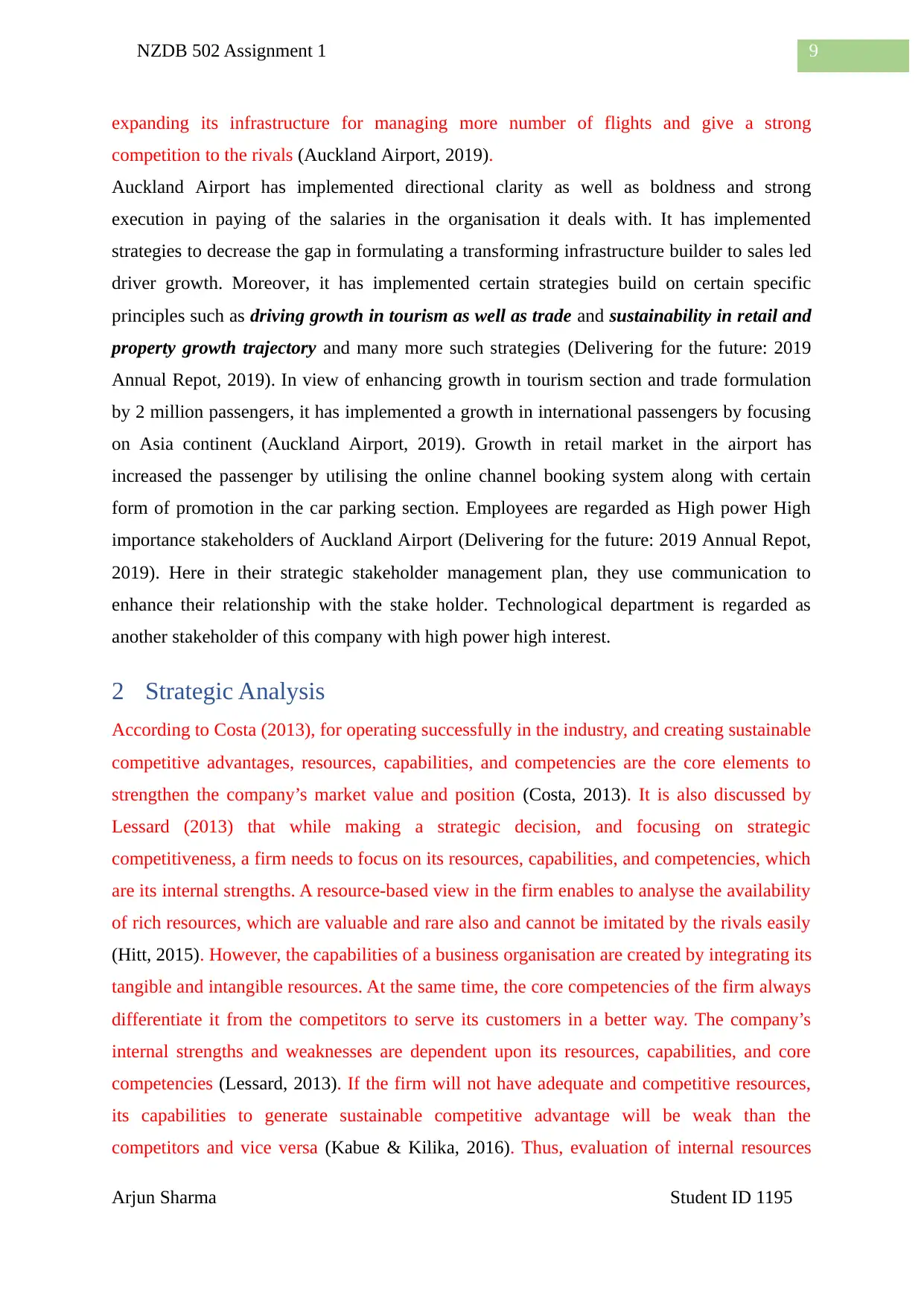
9NZDB 502 Assignment 1
expanding its infrastructure for managing more number of flights and give a strong
competition to the rivals (Auckland Airport, 2019).
Auckland Airport has implemented directional clarity as well as boldness and strong
execution in paying of the salaries in the organisation it deals with. It has implemented
strategies to decrease the gap in formulating a transforming infrastructure builder to sales led
driver growth. Moreover, it has implemented certain strategies build on certain specific
principles such as driving growth in tourism as well as trade and sustainability in retail and
property growth trajectory and many more such strategies (Delivering for the future: 2019
Annual Repot, 2019). In view of enhancing growth in tourism section and trade formulation
by 2 million passengers, it has implemented a growth in international passengers by focusing
on Asia continent (Auckland Airport, 2019). Growth in retail market in the airport has
increased the passenger by utilising the online channel booking system along with certain
form of promotion in the car parking section. Employees are regarded as High power High
importance stakeholders of Auckland Airport (Delivering for the future: 2019 Annual Repot,
2019). Here in their strategic stakeholder management plan, they use communication to
enhance their relationship with the stake holder. Technological department is regarded as
another stakeholder of this company with high power high interest.
2 Strategic Analysis
According to Costa (2013), for operating successfully in the industry, and creating sustainable
competitive advantages, resources, capabilities, and competencies are the core elements to
strengthen the company’s market value and position (Costa, 2013). It is also discussed by
Lessard (2013) that while making a strategic decision, and focusing on strategic
competitiveness, a firm needs to focus on its resources, capabilities, and competencies, which
are its internal strengths. A resource-based view in the firm enables to analyse the availability
of rich resources, which are valuable and rare also and cannot be imitated by the rivals easily
(Hitt, 2015). However, the capabilities of a business organisation are created by integrating its
tangible and intangible resources. At the same time, the core competencies of the firm always
differentiate it from the competitors to serve its customers in a better way. The company’s
internal strengths and weaknesses are dependent upon its resources, capabilities, and core
competencies (Lessard, 2013). If the firm will not have adequate and competitive resources,
its capabilities to generate sustainable competitive advantage will be weak than the
competitors and vice versa (Kabue & Kilika, 2016). Thus, evaluation of internal resources
Arjun Sharma Student ID 1195
expanding its infrastructure for managing more number of flights and give a strong
competition to the rivals (Auckland Airport, 2019).
Auckland Airport has implemented directional clarity as well as boldness and strong
execution in paying of the salaries in the organisation it deals with. It has implemented
strategies to decrease the gap in formulating a transforming infrastructure builder to sales led
driver growth. Moreover, it has implemented certain strategies build on certain specific
principles such as driving growth in tourism as well as trade and sustainability in retail and
property growth trajectory and many more such strategies (Delivering for the future: 2019
Annual Repot, 2019). In view of enhancing growth in tourism section and trade formulation
by 2 million passengers, it has implemented a growth in international passengers by focusing
on Asia continent (Auckland Airport, 2019). Growth in retail market in the airport has
increased the passenger by utilising the online channel booking system along with certain
form of promotion in the car parking section. Employees are regarded as High power High
importance stakeholders of Auckland Airport (Delivering for the future: 2019 Annual Repot,
2019). Here in their strategic stakeholder management plan, they use communication to
enhance their relationship with the stake holder. Technological department is regarded as
another stakeholder of this company with high power high interest.
2 Strategic Analysis
According to Costa (2013), for operating successfully in the industry, and creating sustainable
competitive advantages, resources, capabilities, and competencies are the core elements to
strengthen the company’s market value and position (Costa, 2013). It is also discussed by
Lessard (2013) that while making a strategic decision, and focusing on strategic
competitiveness, a firm needs to focus on its resources, capabilities, and competencies, which
are its internal strengths. A resource-based view in the firm enables to analyse the availability
of rich resources, which are valuable and rare also and cannot be imitated by the rivals easily
(Hitt, 2015). However, the capabilities of a business organisation are created by integrating its
tangible and intangible resources. At the same time, the core competencies of the firm always
differentiate it from the competitors to serve its customers in a better way. The company’s
internal strengths and weaknesses are dependent upon its resources, capabilities, and core
competencies (Lessard, 2013). If the firm will not have adequate and competitive resources,
its capabilities to generate sustainable competitive advantage will be weak than the
competitors and vice versa (Kabue & Kilika, 2016). Thus, evaluation of internal resources
Arjun Sharma Student ID 1195
⊘ This is a preview!⊘
Do you want full access?
Subscribe today to unlock all pages.

Trusted by 1+ million students worldwide
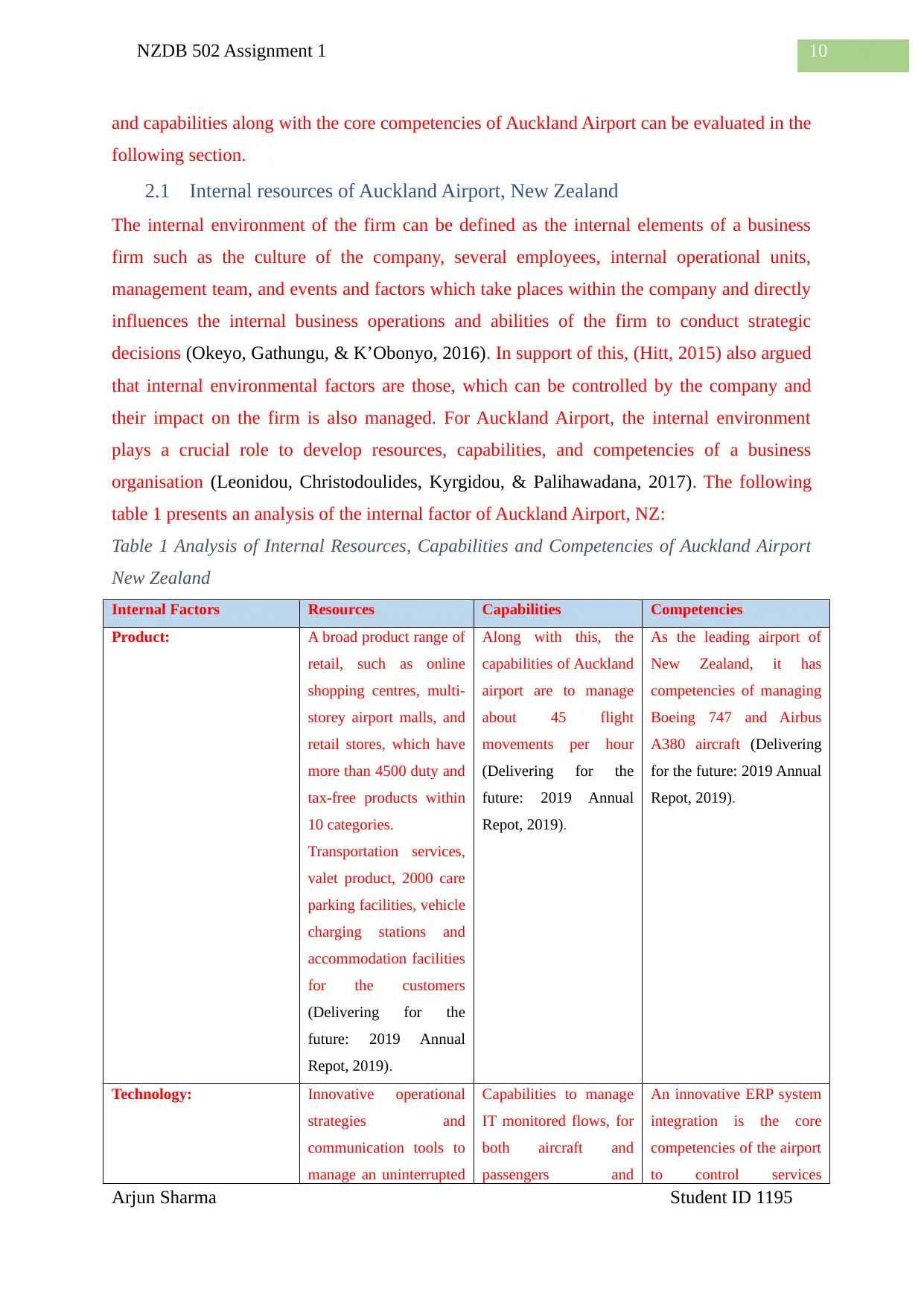
10NZDB 502 Assignment 1
and capabilities along with the core competencies of Auckland Airport can be evaluated in the
following section.
2.1 Internal resources of Auckland Airport, New Zealand
The internal environment of the firm can be defined as the internal elements of a business
firm such as the culture of the company, several employees, internal operational units,
management team, and events and factors which take places within the company and directly
influences the internal business operations and abilities of the firm to conduct strategic
decisions (Okeyo, Gathungu, & K’Obonyo, 2016). In support of this, (Hitt, 2015) also argued
that internal environmental factors are those, which can be controlled by the company and
their impact on the firm is also managed. For Auckland Airport, the internal environment
plays a crucial role to develop resources, capabilities, and competencies of a business
organisation (Leonidou, Christodoulides, Kyrgidou, & Palihawadana, 2017). The following
table 1 presents an analysis of the internal factor of Auckland Airport, NZ:
Table 1 Analysis of Internal Resources, Capabilities and Competencies of Auckland Airport
New Zealand
Internal Factors Resources Capabilities Competencies
Product: A broad product range of
retail, such as online
shopping centres, multi-
storey airport malls, and
retail stores, which have
more than 4500 duty and
tax-free products within
10 categories.
Transportation services,
valet product, 2000 care
parking facilities, vehicle
charging stations and
accommodation facilities
for the customers
(Delivering for the
future: 2019 Annual
Repot, 2019).
Along with this, the
capabilities of Auckland
airport are to manage
about 45 flight
movements per hour
(Delivering for the
future: 2019 Annual
Repot, 2019).
As the leading airport of
New Zealand, it has
competencies of managing
Boeing 747 and Airbus
A380 aircraft (Delivering
for the future: 2019 Annual
Repot, 2019).
Technology: Innovative operational
strategies and
communication tools to
manage an uninterrupted
Capabilities to manage
IT monitored flows, for
both aircraft and
passengers and
An innovative ERP system
integration is the core
competencies of the airport
to control services
Arjun Sharma Student ID 1195
and capabilities along with the core competencies of Auckland Airport can be evaluated in the
following section.
2.1 Internal resources of Auckland Airport, New Zealand
The internal environment of the firm can be defined as the internal elements of a business
firm such as the culture of the company, several employees, internal operational units,
management team, and events and factors which take places within the company and directly
influences the internal business operations and abilities of the firm to conduct strategic
decisions (Okeyo, Gathungu, & K’Obonyo, 2016). In support of this, (Hitt, 2015) also argued
that internal environmental factors are those, which can be controlled by the company and
their impact on the firm is also managed. For Auckland Airport, the internal environment
plays a crucial role to develop resources, capabilities, and competencies of a business
organisation (Leonidou, Christodoulides, Kyrgidou, & Palihawadana, 2017). The following
table 1 presents an analysis of the internal factor of Auckland Airport, NZ:
Table 1 Analysis of Internal Resources, Capabilities and Competencies of Auckland Airport
New Zealand
Internal Factors Resources Capabilities Competencies
Product: A broad product range of
retail, such as online
shopping centres, multi-
storey airport malls, and
retail stores, which have
more than 4500 duty and
tax-free products within
10 categories.
Transportation services,
valet product, 2000 care
parking facilities, vehicle
charging stations and
accommodation facilities
for the customers
(Delivering for the
future: 2019 Annual
Repot, 2019).
Along with this, the
capabilities of Auckland
airport are to manage
about 45 flight
movements per hour
(Delivering for the
future: 2019 Annual
Repot, 2019).
As the leading airport of
New Zealand, it has
competencies of managing
Boeing 747 and Airbus
A380 aircraft (Delivering
for the future: 2019 Annual
Repot, 2019).
Technology: Innovative operational
strategies and
communication tools to
manage an uninterrupted
Capabilities to manage
IT monitored flows, for
both aircraft and
passengers and
An innovative ERP system
integration is the core
competencies of the airport
to control services
Arjun Sharma Student ID 1195
Paraphrase This Document
Need a fresh take? Get an instant paraphrase of this document with our AI Paraphraser
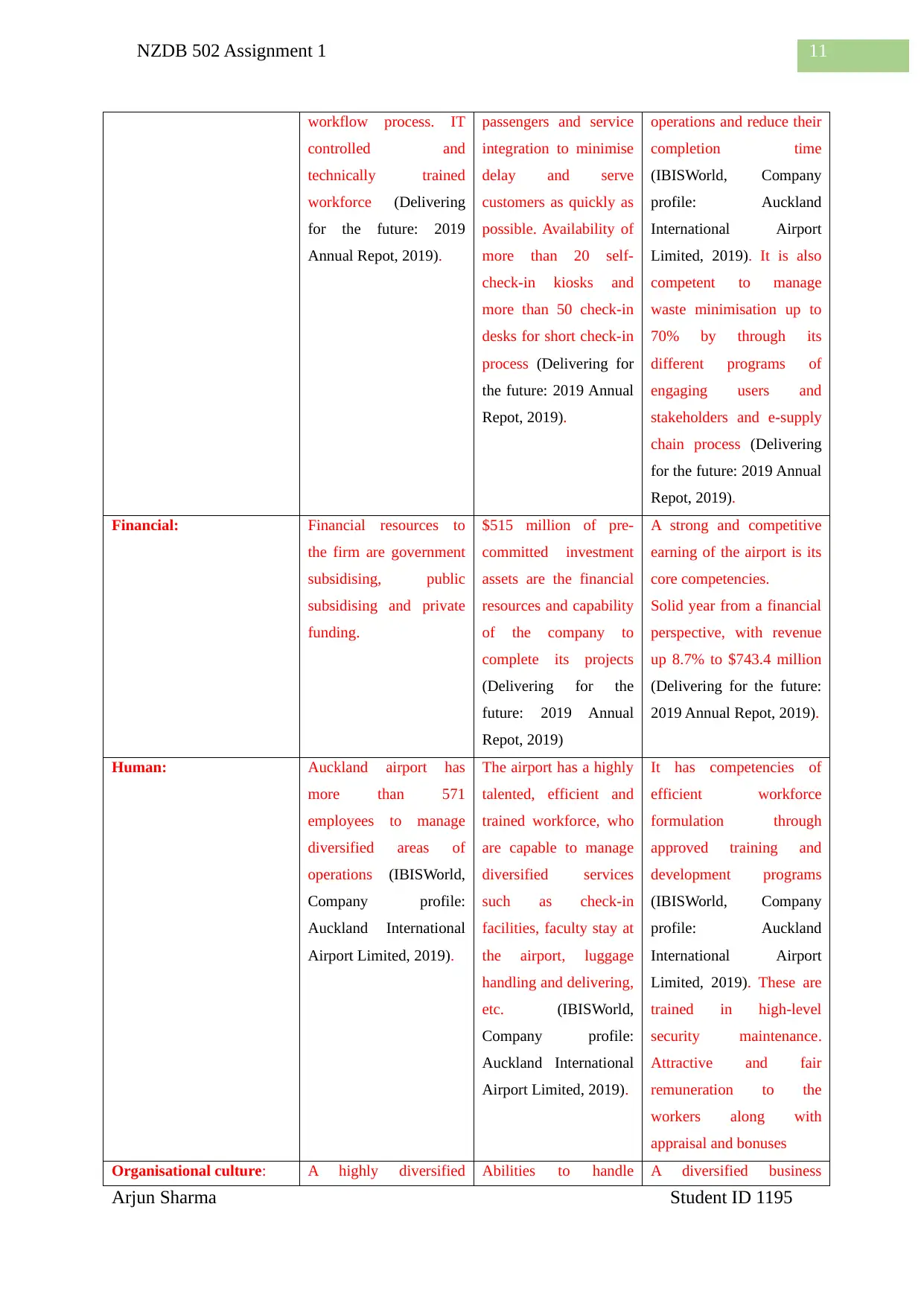
11NZDB 502 Assignment 1
workflow process. IT
controlled and
technically trained
workforce (Delivering
for the future: 2019
Annual Repot, 2019).
passengers and service
integration to minimise
delay and serve
customers as quickly as
possible. Availability of
more than 20 self-
check-in kiosks and
more than 50 check-in
desks for short check-in
process (Delivering for
the future: 2019 Annual
Repot, 2019).
operations and reduce their
completion time
(IBISWorld, Company
profile: Auckland
International Airport
Limited, 2019). It is also
competent to manage
waste minimisation up to
70% by through its
different programs of
engaging users and
stakeholders and e-supply
chain process (Delivering
for the future: 2019 Annual
Repot, 2019).
Financial: Financial resources to
the firm are government
subsidising, public
subsidising and private
funding.
$515 million of pre-
committed investment
assets are the financial
resources and capability
of the company to
complete its projects
(Delivering for the
future: 2019 Annual
Repot, 2019)
A strong and competitive
earning of the airport is its
core competencies.
Solid year from a financial
perspective, with revenue
up 8.7% to $743.4 million
(Delivering for the future:
2019 Annual Repot, 2019).
Human: Auckland airport has
more than 571
employees to manage
diversified areas of
operations (IBISWorld,
Company profile:
Auckland International
Airport Limited, 2019).
The airport has a highly
talented, efficient and
trained workforce, who
are capable to manage
diversified services
such as check-in
facilities, faculty stay at
the airport, luggage
handling and delivering,
etc. (IBISWorld,
Company profile:
Auckland International
Airport Limited, 2019).
It has competencies of
efficient workforce
formulation through
approved training and
development programs
(IBISWorld, Company
profile: Auckland
International Airport
Limited, 2019). These are
trained in high-level
security maintenance.
Attractive and fair
remuneration to the
workers along with
appraisal and bonuses
Organisational culture: A highly diversified Abilities to handle A diversified business
Arjun Sharma Student ID 1195
workflow process. IT
controlled and
technically trained
workforce (Delivering
for the future: 2019
Annual Repot, 2019).
passengers and service
integration to minimise
delay and serve
customers as quickly as
possible. Availability of
more than 20 self-
check-in kiosks and
more than 50 check-in
desks for short check-in
process (Delivering for
the future: 2019 Annual
Repot, 2019).
operations and reduce their
completion time
(IBISWorld, Company
profile: Auckland
International Airport
Limited, 2019). It is also
competent to manage
waste minimisation up to
70% by through its
different programs of
engaging users and
stakeholders and e-supply
chain process (Delivering
for the future: 2019 Annual
Repot, 2019).
Financial: Financial resources to
the firm are government
subsidising, public
subsidising and private
funding.
$515 million of pre-
committed investment
assets are the financial
resources and capability
of the company to
complete its projects
(Delivering for the
future: 2019 Annual
Repot, 2019)
A strong and competitive
earning of the airport is its
core competencies.
Solid year from a financial
perspective, with revenue
up 8.7% to $743.4 million
(Delivering for the future:
2019 Annual Repot, 2019).
Human: Auckland airport has
more than 571
employees to manage
diversified areas of
operations (IBISWorld,
Company profile:
Auckland International
Airport Limited, 2019).
The airport has a highly
talented, efficient and
trained workforce, who
are capable to manage
diversified services
such as check-in
facilities, faculty stay at
the airport, luggage
handling and delivering,
etc. (IBISWorld,
Company profile:
Auckland International
Airport Limited, 2019).
It has competencies of
efficient workforce
formulation through
approved training and
development programs
(IBISWorld, Company
profile: Auckland
International Airport
Limited, 2019). These are
trained in high-level
security maintenance.
Attractive and fair
remuneration to the
workers along with
appraisal and bonuses
Organisational culture: A highly diversified Abilities to handle A diversified business
Arjun Sharma Student ID 1195
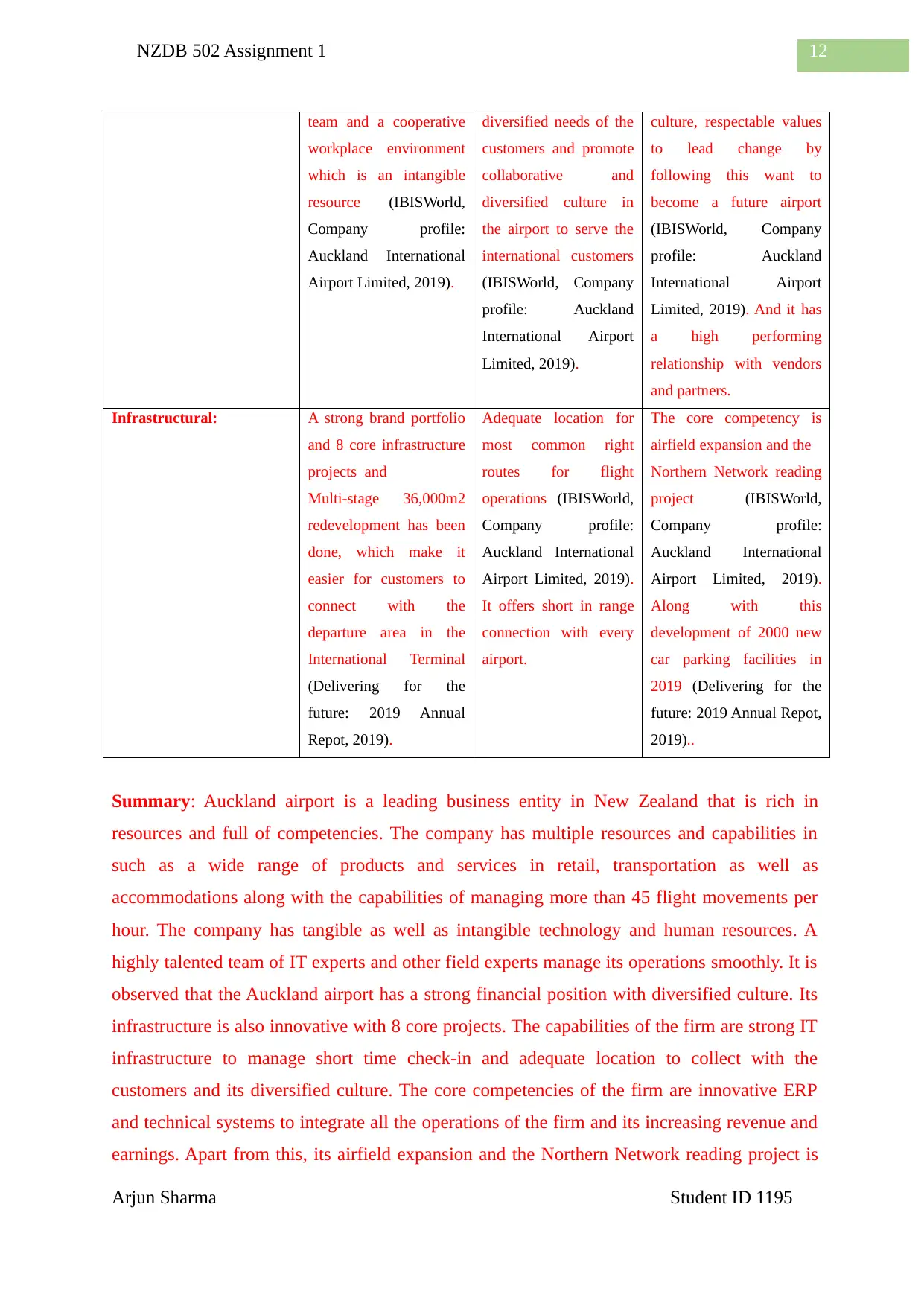
12NZDB 502 Assignment 1
team and a cooperative
workplace environment
which is an intangible
resource (IBISWorld,
Company profile:
Auckland International
Airport Limited, 2019).
diversified needs of the
customers and promote
collaborative and
diversified culture in
the airport to serve the
international customers
(IBISWorld, Company
profile: Auckland
International Airport
Limited, 2019).
culture, respectable values
to lead change by
following this want to
become a future airport
(IBISWorld, Company
profile: Auckland
International Airport
Limited, 2019). And it has
a high performing
relationship with vendors
and partners.
Infrastructural: A strong brand portfolio
and 8 core infrastructure
projects and
Multi-stage 36,000m2
redevelopment has been
done, which make it
easier for customers to
connect with the
departure area in the
International Terminal
(Delivering for the
future: 2019 Annual
Repot, 2019).
Adequate location for
most common right
routes for flight
operations (IBISWorld,
Company profile:
Auckland International
Airport Limited, 2019).
It offers short in range
connection with every
airport.
The core competency is
airfield expansion and the
Northern Network reading
project (IBISWorld,
Company profile:
Auckland International
Airport Limited, 2019).
Along with this
development of 2000 new
car parking facilities in
2019 (Delivering for the
future: 2019 Annual Repot,
2019)..
Summary: Auckland airport is a leading business entity in New Zealand that is rich in
resources and full of competencies. The company has multiple resources and capabilities in
such as a wide range of products and services in retail, transportation as well as
accommodations along with the capabilities of managing more than 45 flight movements per
hour. The company has tangible as well as intangible technology and human resources. A
highly talented team of IT experts and other field experts manage its operations smoothly. It is
observed that the Auckland airport has a strong financial position with diversified culture. Its
infrastructure is also innovative with 8 core projects. The capabilities of the firm are strong IT
infrastructure to manage short time check-in and adequate location to collect with the
customers and its diversified culture. The core competencies of the firm are innovative ERP
and technical systems to integrate all the operations of the firm and its increasing revenue and
earnings. Apart from this, its airfield expansion and the Northern Network reading project is
Arjun Sharma Student ID 1195
team and a cooperative
workplace environment
which is an intangible
resource (IBISWorld,
Company profile:
Auckland International
Airport Limited, 2019).
diversified needs of the
customers and promote
collaborative and
diversified culture in
the airport to serve the
international customers
(IBISWorld, Company
profile: Auckland
International Airport
Limited, 2019).
culture, respectable values
to lead change by
following this want to
become a future airport
(IBISWorld, Company
profile: Auckland
International Airport
Limited, 2019). And it has
a high performing
relationship with vendors
and partners.
Infrastructural: A strong brand portfolio
and 8 core infrastructure
projects and
Multi-stage 36,000m2
redevelopment has been
done, which make it
easier for customers to
connect with the
departure area in the
International Terminal
(Delivering for the
future: 2019 Annual
Repot, 2019).
Adequate location for
most common right
routes for flight
operations (IBISWorld,
Company profile:
Auckland International
Airport Limited, 2019).
It offers short in range
connection with every
airport.
The core competency is
airfield expansion and the
Northern Network reading
project (IBISWorld,
Company profile:
Auckland International
Airport Limited, 2019).
Along with this
development of 2000 new
car parking facilities in
2019 (Delivering for the
future: 2019 Annual Repot,
2019)..
Summary: Auckland airport is a leading business entity in New Zealand that is rich in
resources and full of competencies. The company has multiple resources and capabilities in
such as a wide range of products and services in retail, transportation as well as
accommodations along with the capabilities of managing more than 45 flight movements per
hour. The company has tangible as well as intangible technology and human resources. A
highly talented team of IT experts and other field experts manage its operations smoothly. It is
observed that the Auckland airport has a strong financial position with diversified culture. Its
infrastructure is also innovative with 8 core projects. The capabilities of the firm are strong IT
infrastructure to manage short time check-in and adequate location to collect with the
customers and its diversified culture. The core competencies of the firm are innovative ERP
and technical systems to integrate all the operations of the firm and its increasing revenue and
earnings. Apart from this, its airfield expansion and the Northern Network reading project is
Arjun Sharma Student ID 1195
⊘ This is a preview!⊘
Do you want full access?
Subscribe today to unlock all pages.

Trusted by 1+ million students worldwide
1 out of 60
Related Documents
Your All-in-One AI-Powered Toolkit for Academic Success.
+13062052269
info@desklib.com
Available 24*7 on WhatsApp / Email
![[object Object]](/_next/static/media/star-bottom.7253800d.svg)
Unlock your academic potential
Copyright © 2020–2025 A2Z Services. All Rights Reserved. Developed and managed by ZUCOL.





